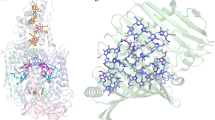Abstract
The steady state and time domain spectroscopy of 9-aminoacridinium hydrochloride have been studied. 9-aminoacridine (I), 9-aminoacridinium (II) and the double protonated ion (III) follow Waterman’s principle with respect to their spectra and lifetimes. It is established that the excimer formation in (II) is from the ground state dimers which undergo either thermally-activated radiationless excimer conversion or a geometrical rearrangement in the excited state at room temperature. The quenching of monomer emission by dimers or foreign quenchers (KI) is found to be of transient nature as suggested by the continuum model.
Similar content being viewed by others
References
Acheson R M 1956The chemistry of heterocyclic compounds (New York: Interscience) Vol. 9
Birk J B 1970Photophysics of aromatic molecules (New York: Wiley Interscience)
Gangola P, Joshi N B and Pant D D 1981aChem. Phys. Lett. 80 418
Gangola P, Joshi N B and Pant D D 1981bCurr. Sci. 50 711
Mataga N and Kubota T 1970Molecular interactions and electronic spectrum (New York: Marcel Dekker)
Noyes R M 1964J. Am. Chem. Soc. 86 4529
Pant D D, Joshi G C and Tripathi H B 1986Indian J. Phys. 60B 7
Saigusa H and Itoh M 1985J. Phys. Chem. 89 5486
Shah J, Pant H C and Pant D D 1985Chem. Phys. Lett. 115 192
Smoluchowskii M V 1917Z. Phys. Chem. 92 129
Ware W R and Nemzek T L 1975J. Chem. Phys. 62 477
Ware W R and Novros J S 1966J. Phys. Chem. 70 3246
Zanker V and Reichel A 1962Proc. Int. Meeting on Molecular Spectroscopy, Bologna 2 596
Author information
Authors and Affiliations
Additional information
The authors felicitate Prof. D S Kothari on his eightieth birthday and dedicate this paper to him on this occasion.
Rights and permissions
About this article
Cite this article
Pant, D.D., Joshi, G.C. & Tripathi, H.B. Photophysics of 9-aminoacridinium hydrochloride. Pramana - J Phys 27, 161–170 (1986). https://doi.org/10.1007/BF02846336
Issue Date:
DOI: https://doi.org/10.1007/BF02846336




